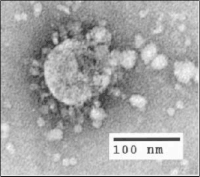
Photo from wikipedia
The initial step of infection by severe acute respiratory syndrome coronavirus 2 (SARS‐CoV‐2) involves the binding of receptor binding domain (RBD) of the spike protein to the angiotensin converting enzyme… Click to show full abstract
The initial step of infection by severe acute respiratory syndrome coronavirus 2 (SARS‐CoV‐2) involves the binding of receptor binding domain (RBD) of the spike protein to the angiotensin converting enzyme 2 (ACE2) receptor. Each successive wave of SARS‐CoV‐2 reports emergence of many new variants, which is associated with mutations in the RBD as well as other parts of the spike protein. These mutations are reported to have enhanced affinity towards the ACE2 receptor as well as are also crucial for the virus transmission. Many computational and experimental studies have demonstrated the effect of individual mutation on the RBD‐ACE2 binding. However, the cumulative effect of mutations on the RBD and away from the RBD was not investigated in detail. We report here a comparative analysis on the structural communication and dynamics of the RBD and truncated S1 domain of spike protein in complex with the ACE2 receptor from SARS‐CoV‐2 wild type and its P.1 variant. Our integrative network and dynamics approaches highlighted a subtle conformational changes in the RBD as well as truncated S1 domain of spike protein at the protein contact level, responsible for the increased affinity with the ACE2 receptor. Moreover, our study also identified the commonalities and differences in the dynamics of the interactions between spike protein of SARS‐CoV‐2 wild type and its P.1 variant with the ACE2 receptor. Further, our investigation yielded an understanding towards identification of the unique RBD residues crucial for the interaction with the ACE2 host receptor. Overall, the study provides an insight for designing better therapeutics against the circulating P.1 variants as well as other future variants.
Journal Title: Journal of Cellular Biochemistry
Year Published: 2022
Link to full text (if available)
Share on Social Media: Sign Up to like & get
recommendations!